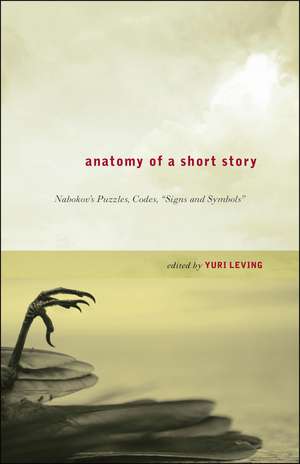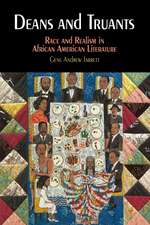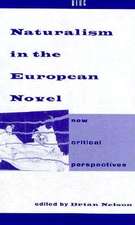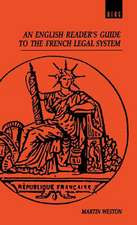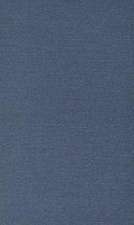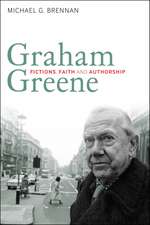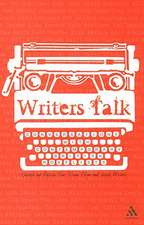Anatomy of a Short Story: Nabokov's Puzzles, Codes, "Signs and Symbols"
Editat de Professor Yuri Levingen Limba Engleză Paperback – 8 aug 2012
| Toate formatele și edițiile | Preț | Express |
|---|---|---|
| Paperback (1) | 259.79 lei 43-57 zile | |
| Bloomsbury Publishing – 8 aug 2012 | 259.79 lei 43-57 zile | |
| Hardback (1) | 835.76 lei 43-57 zile | |
| Bloomsbury Publishing – 8 aug 2012 | 835.76 lei 43-57 zile |
Preț: 259.79 lei
Preț vechi: 296.59 lei
-12% Nou
Puncte Express: 390
Preț estimativ în valută:
49.72€ • 51.71$ • 41.04£
49.72€ • 51.71$ • 41.04£
Carte tipărită la comandă
Livrare economică 14-28 aprilie
Preluare comenzi: 021 569.72.76
Specificații
ISBN-13: 9781441142634
ISBN-10: 1441142630
Pagini: 432
Ilustrații: 6 illus
Dimensiuni: 138 x 216 x 25 mm
Greutate: 0.48 kg
Ediția:New.
Editura: Bloomsbury Publishing
Colecția Continuum
Locul publicării:New York, United States
ISBN-10: 1441142630
Pagini: 432
Ilustrații: 6 illus
Dimensiuni: 138 x 216 x 25 mm
Greutate: 0.48 kg
Ediția:New.
Editura: Bloomsbury Publishing
Colecția Continuum
Locul publicării:New York, United States
Caracteristici
Will introduce and investigate the complexity and the intellectual beauty of Nabokov's writing style
Notă biografică
Yuri Leving is Professor and Chair in the Department of Russian Studies, Dalhousie University, Canada. He is the author of three books, including Train Station - Garage - Hangar. Vladimir Nabokov and the Poetics of Russian Urbanism (2004) and Keys to The Gift. A Guide to V. Nabokov's Novel (2011), and has also co-edited three volumes, including Empire N: Nabokov and His Heirs (2006) and Goalkeeper: The Nabokov Almanac (2010). Leving has published over seventy scholarly articles on various aspects of Russian and comparative literature. He served as a commentator on the first authorized Russian edition of The Collected Works of Vladimir Nabokov in five volumes (1999-2001), and was the curator for the exhibition "Nabokov's Lolita: 1955-2005" in Washington, D.C., which celebrated the 50th anniversary of the publication of Lolita.
Cuprins
Contributors
Acknowledgments
INTRODUCTION
Acknowledgments
INTRODUCTION
Breaking the Code: Nabokov and the Art of Short Fiction
Yuri Leving
A PRIMARY TEXT:
Heart
"Signs and Symbols"
Vladimir Nabokov
FORUM: High pressure
Psychosis, Performance, Schizophrenia, Literature
Hal Ackerman, Murray Biggs, John Crossley, Wayne Goodman, Yuri Leving, and Frederick White
Yuri Leving
A PRIMARY TEXT:
Heart
"Signs and Symbols"
Vladimir Nabokov
FORUM: High pressure
Psychosis, Performance, Schizophrenia, Literature
Hal Ackerman, Murray Biggs, John Crossley, Wayne Goodman, Yuri Leving, and Frederick White
CRITICISM
PART ONE: Bone Structure
Frameworks
Vladimir Nabokov's Correspondence with The New Yorker regarding "Signs and Symbols," 1946-1948
Olga Voronina
Lost in Revision: The Editing of "Signs and Symbols" for The New Yorker
John Morris
Consulting the Oracle
Michael Wood
PART TWO: Vascular System
Signs
Arbitrary Signs and Symbols
Alexander N. Drescher
The Patterns of Doom
Brian Quinn
Ways of Knowing in "Signs and Symbols"
Terry J. Martin
A Funny Thing about "Signs and Symbols"
John B. Lane
Names
Yuri Leving
PART THREE: Muscles of the Story
Objects
Five Known Jars
Carol M. Dole
Five Missing Jars
Gennady Barabtarlo
The Last Jar
Joanna Trzeciak
Trees and Birds
Larry R. Andrews
Photographs
Maria-Ruxanda Bontila
Cards
Pekka Tammi
Telephone
Andrés Romero Jódar
PART FOUR: Nervous system
The Importance of Reader Response
Paul J. Rosenzweig
The Jewish Quest
Yuri Leving
Symbols
Signs of Reference, Symbols of Design
Geoffrey Green
Sacred Dangers: Nabokov's Distorted Reflection
David Field
Numbers
The Mysticism of Circle
Mary Tookey
The Semiotics of Zero
Meghan Vicks
PART ONE: Bone Structure
Frameworks
Vladimir Nabokov's Correspondence with The New Yorker regarding "Signs and Symbols," 1946-1948
Olga Voronina
Lost in Revision: The Editing of "Signs and Symbols" for The New Yorker
John Morris
Consulting the Oracle
Michael Wood
PART TWO: Vascular System
Signs
Arbitrary Signs and Symbols
Alexander N. Drescher
The Patterns of Doom
Brian Quinn
Ways of Knowing in "Signs and Symbols"
Terry J. Martin
A Funny Thing about "Signs and Symbols"
John B. Lane
Names
Yuri Leving
PART THREE: Muscles of the Story
Objects
Five Known Jars
Carol M. Dole
Five Missing Jars
Gennady Barabtarlo
The Last Jar
Joanna Trzeciak
Trees and Birds
Larry R. Andrews
Photographs
Maria-Ruxanda Bontila
Cards
Pekka Tammi
Telephone
Andrés Romero Jódar
PART FOUR: Nervous system
The Importance of Reader Response
Paul J. Rosenzweig
The Jewish Quest
Yuri Leving
Symbols
Signs of Reference, Symbols of Design
Geoffrey Green
Sacred Dangers: Nabokov's Distorted Reflection
David Field
Numbers
The Mysticism of Circle
Mary Tookey
The Semiotics of Zero
Meghan Vicks
PART FIVE: Dissection
Web of Contexts
"Signs and Symbols" in and out of Contexts
Leona Toker
"Breaking the News" and "Signs and Symbols": Silentology
Joanna Trzeciak
Pnin and "Signs and Symbols": Narrative Entrapment
David H. Richter
Pnin and "Signs and Symbols": Narrative Strategies
William Carroll
Pale Fire and "Signs and Symbols"
Vladimir Mylnikov
Web of Contexts
"Signs and Symbols" in and out of Contexts
Leona Toker
"Breaking the News" and "Signs and Symbols": Silentology
Joanna Trzeciak
Pnin and "Signs and Symbols": Narrative Entrapment
David H. Richter
Pnin and "Signs and Symbols": Narrative Strategies
William Carroll
Pale Fire and "Signs and Symbols"
Vladimir Mylnikov
PART SIX: DNA Testing
Cracking the Code
The Signs and Symbols in Nabokov's "Signs and Symbols"
Alexander Dolinin
The Castling Problem in "Signs and Symbols"
Yuri Leving
Reading Madly
Irving Malin
Deciphering "Signs and Symbols"
Larry R. Andrews
Decoding "Signs and Symbols"
John V. Hagopian
The Referential Mania: An Attempt of the Deconstructivist Reading
Álvaro Garrido Moreno
A Referential Reading of Nabokov's "Signs and Symbols"
Charles W. Mignon
An Afterword
John Banville
Alternative Tables of Contents
Chronological Key
Alphabetical Key
Credits
Bibliography
Index
Cracking the Code
The Signs and Symbols in Nabokov's "Signs and Symbols"
Alexander Dolinin
The Castling Problem in "Signs and Symbols"
Yuri Leving
Reading Madly
Irving Malin
Deciphering "Signs and Symbols"
Larry R. Andrews
Decoding "Signs and Symbols"
John V. Hagopian
The Referential Mania: An Attempt of the Deconstructivist Reading
Álvaro Garrido Moreno
A Referential Reading of Nabokov's "Signs and Symbols"
Charles W. Mignon
An Afterword
John Banville
Alternative Tables of Contents
Chronological Key
Alphabetical Key
Credits
Bibliography
Index
Recenzii
"Signs or symbols, satire or realism, closure or no closure, soluble or insoluble riddle? Responding to the challenge presented by this enigmatic short story, aware that Nabokov did not believe in what he called 'the symbolism racket', the contributors to this excellent collection of articles have mobilized a wide spectrum of hermeneutics. Convinced, with John V. Hagopian, that 'no legitimate artist produces randomness', they gamely attempted to quiz the author's elusive figure, developing a brand of creative paranoia, yet never claiming, except in one case (Dolinin), to play the part of the oracle. The result is a challenging exercise of 'Practical Criticism' which touches upon the bone and structure of Nabokov's work." -- Maurice Couturier, Professor Emeritus, University of Nice, France, writer and translator, editor-in-chief of the Pléiade edtion of Nabokov's novels.
The critical anthology is called "Anatomy of a Short Story" not accidentally. What we have here is not a marauding or exhuming of a senseless body, but a study of a living artistic organism. Collective dissection presupposes using various methods, diversified optics and descriptive procedures. Yuri Leving's own array of scholarly interests turns "Anatomy" from a potentially dull registrar's compendium into a collection of peculiar and often unexpected utterances about Nabokov's text. This book will prove handy to anyone interested both in Nabokov as well as in studying literary texts in general.
Leving's collection is a huge achievement, and its scope is impressive, with thirty articles in total, mostly previously published, spanning over thirty years of scholarship. This is the book's foremost triumph and as such positions itself alongside the Garland Companion to Vladimir Nabokov, is a must for anyone interested in Nabokov's story and, more generally, the historical progression of Nabokov studies.
Following the success of his Keys to the Gift: A Guide to Vladimir Nabokov's Novel (Boston, MA, 2011) Leving's latest foray into Nabokov studies comes at a crucial moment in the field. Little has been published on Nabokov in recent years that matches the powerhouse of scholarship of the past; maybe the time is right to address where we are with Nabokov and, potentially, where we are going. In this regard Leving's collection is a huge achievement, and its scope is impressive, with thirty articles in total, mostly previously published, spanning over thirty years of scholarship. This is the book's foremost triumph and as such positions itself alongside the Garland Companion to Vladimir Nabokov (New York, 1995), is a must for anyone interested in Nabokov's story and, more generally, the historical progression of Nabokov studies.
The critical anthology is called "Anatomy of a Short Story" not accidentally. What we have here is not a marauding or exhuming of a senseless body, but a study of a living artistic organism. Collective dissection presupposes using various methods, diversified optics and descriptive procedures. Yuri Leving's own array of scholarly interests turns "Anatomy" from a potentially dull registrar's compendium into a collection of peculiar and often unexpected utterances about Nabokov's text. This book will prove handy to anyone interested both in Nabokov as well as in studying literary texts in general.
Leving's collection is a huge achievement, and its scope is impressive, with thirty articles in total, mostly previously published, spanning over thirty years of scholarship. This is the book's foremost triumph and as such positions itself alongside the Garland Companion to Vladimir Nabokov, is a must for anyone interested in Nabokov's story and, more generally, the historical progression of Nabokov studies.
Following the success of his Keys to the Gift: A Guide to Vladimir Nabokov's Novel (Boston, MA, 2011) Leving's latest foray into Nabokov studies comes at a crucial moment in the field. Little has been published on Nabokov in recent years that matches the powerhouse of scholarship of the past; maybe the time is right to address where we are with Nabokov and, potentially, where we are going. In this regard Leving's collection is a huge achievement, and its scope is impressive, with thirty articles in total, mostly previously published, spanning over thirty years of scholarship. This is the book's foremost triumph and as such positions itself alongside the Garland Companion to Vladimir Nabokov (New York, 1995), is a must for anyone interested in Nabokov's story and, more generally, the historical progression of Nabokov studies.
Descriere
Descriere de la o altă ediție sau format:
A unique anthology devoted to a single story-"Signs and Symbols" by Vladimir Nabokov-which exposes the way we read and interpret short stories.
A unique anthology devoted to a single story-"Signs and Symbols" by Vladimir Nabokov-which exposes the way we read and interpret short stories.
